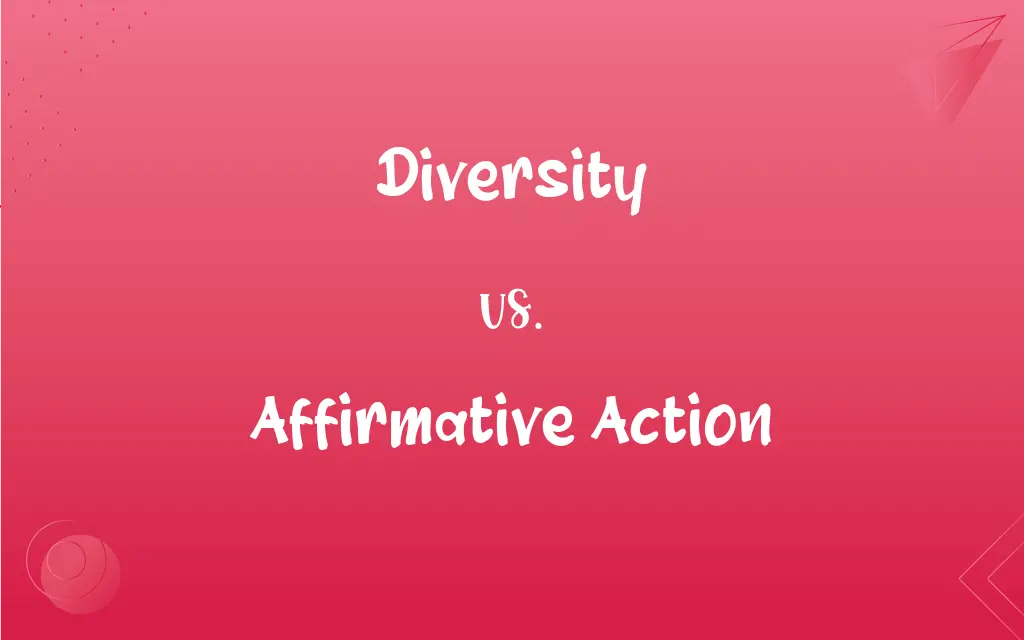Diversity vs. Affirmative Action: What's the Difference?
Edited by Aimie Carlson || By Janet White || Published on February 1, 2024
Diversity refers to the inclusion of different types of people, while affirmative action is a set of policies aimed at increasing the representation of underrepresented groups.

Key Differences
Diversity encompasses a broad range of characteristics including race, gender, age, and cultural background, aiming for representation and inclusion in a group or organization. Affirmative action, conversely, is a policy or a set of policies designed specifically to address historical inequities by providing opportunities to historically marginalized groups.
Diversity focuses on the acknowledgment and appreciation of differences among people in a community or institution, while affirmative action involves concrete steps and measures to correct imbalances in representation and opportunities. The goal of diversity is to create a varied and inclusive environment, whereas affirmative action seeks to remedy past discrimination and disadvantages.
In the context of employment, diversity might refer to hiring a workforce that reflects a wide array of backgrounds and perspectives. Affirmative action, on the other hand, might involve specific recruitment strategies or quotas to ensure that certain groups, historically disadvantaged, are adequately represented.
Educational institutions embrace diversity by fostering an environment where students and faculty from diverse backgrounds can thrive. Affirmative action in education might involve admission policies that give added consideration to candidates from certain groups to create a more equitable and representative student body.
Diversity initiatives can be seen in all facets of society, aiming to reflect the rich tapestry of human differences. Affirmative action is more focused, targeting specific sectors or groups where disparities are most evident, with policies aimed at leveling the playing field.
ADVERTISEMENT
Comparison Chart
Goal
Inclusion of varied backgrounds
Addressing historical inequities
Focus
Broad spectrum of differences
Specific underrepresented groups
Implementation
Inclusion in all activities
Targeted policies and measures
Outcome Measured
Variety and representation
Equity in opportunity and treatment
Context
Societal, organizational, cultural
Legal, institutional policies
ADVERTISEMENT
Diversity and Affirmative Action Definitions
Diversity
Diversity encompasses a mix of cultural, ethnic, and gender differences within a population.
The festival celebrated the diversity of the city's community.
Affirmative Action
Affirmative action involves measures to improve opportunities for historically excluded groups.
Affirmative action in hiring helps address past discrimination.
Diversity
Diversity is the presence of a wide range of different qualities and attributes in a group.
The diversity of the team's skills contributed to its success.
Affirmative Action
Affirmative action encompasses steps taken to increase the representation of women and minorities.
The company adopted affirmative action to diversify its staff.
Diversity
Diversity is the state of having people who are different races or who have different cultures in a group.
Our school's diversity is its strength.
Affirmative Action
Affirmative action is a set of procedures designed to eliminate unlawful discrimination.
Affirmative action is essential for creating a fair workplace.
Diversity
Diversity refers to the inclusion of individuals from various backgrounds and identities.
The company's commitment to diversity is evident in its multicultural workforce.
Affirmative Action
Affirmative action is a policy favoring those who tend to suffer from discrimination.
The university's affirmative action policy aims to increase minority representation.
Diversity
Diversity pertains to a range of different ideas, opinions, and perspectives.
The diversity of opinions in the meeting led to a creative solution.
Affirmative Action
Affirmative action refers to active efforts to increase diversity and redress imbalances.
The government's affirmative action program supports equal opportunity.
Diversity
The quality or condition of being diverse
A band known for the diversity of its music.
Diversity
The condition of having or including people from different ethnicities and social backgrounds
Diversity on campus.
FAQs
What is affirmative action?
Affirmative action is a policy to increase opportunities for historically underrepresented groups.
Can diversity exist without affirmative action?
Yes, diversity can exist without affirmative action, but affirmative action can help in achieving diversity.
How does diversity differ in the workplace compared to society?
In the workplace, diversity focuses on inclusive hiring, while in society, it's about acknowledging different cultures and backgrounds.
Does affirmative action mean lower standards for certain groups?
No, it aims to level the playing field, not lower standards.
What is diversity?
Diversity refers to the inclusion of people from various backgrounds and identities.
Is affirmative action only about race?
No, it also includes gender, disability, and other factors.
Is affirmative action legally required?
Affirmative action is required in some contexts, especially where there has been historical discrimination.
How can a company improve its diversity?
By implementing inclusive hiring practices and promoting a culture of acceptance.
Can affirmative action lead to reverse discrimination?
It's a concern, but the aim is to promote fairness, not reverse discrimination.
What's the main goal of affirmative action?
To correct imbalances and ensure equal opportunities.
What are the benefits of diversity in education?
It leads to a richer learning environment and prepares students for a diverse world.
Can diversity lead to conflicts?
It can, but effective management turns diversity into strength.
How do diversity and affirmative action affect company culture?
They create an inclusive and respectful environment.
Are there different types of diversity?
Yes, including cultural, ethnic, gender, and ideological diversity.
What challenges can arise with diversity initiatives?
Potential resistance and the complexity of implementation.
How is diversity measured?
By the representation of different groups and perspectives.
What's the future of affirmative action?
It's evolving, focusing more on broad inclusivity and less on quotas.
How does diversity impact teamwork?
It brings varied perspectives, leading to more innovative solutions.
Does affirmative action apply to all businesses?
It mainly applies to public institutions and contractors.
How does affirmative action impact recruitment?
It encourages hiring from a diverse pool of candidates.
About Author
Written by
Janet WhiteJanet White has been an esteemed writer and blogger for Difference Wiki. Holding a Master's degree in Science and Medical Journalism from the prestigious Boston University, she has consistently demonstrated her expertise and passion for her field. When she's not immersed in her work, Janet relishes her time exercising, delving into a good book, and cherishing moments with friends and family.
Edited by
Aimie CarlsonAimie Carlson, holding a master's degree in English literature, is a fervent English language enthusiast. She lends her writing talents to Difference Wiki, a prominent website that specializes in comparisons, offering readers insightful analyses that both captivate and inform.































































